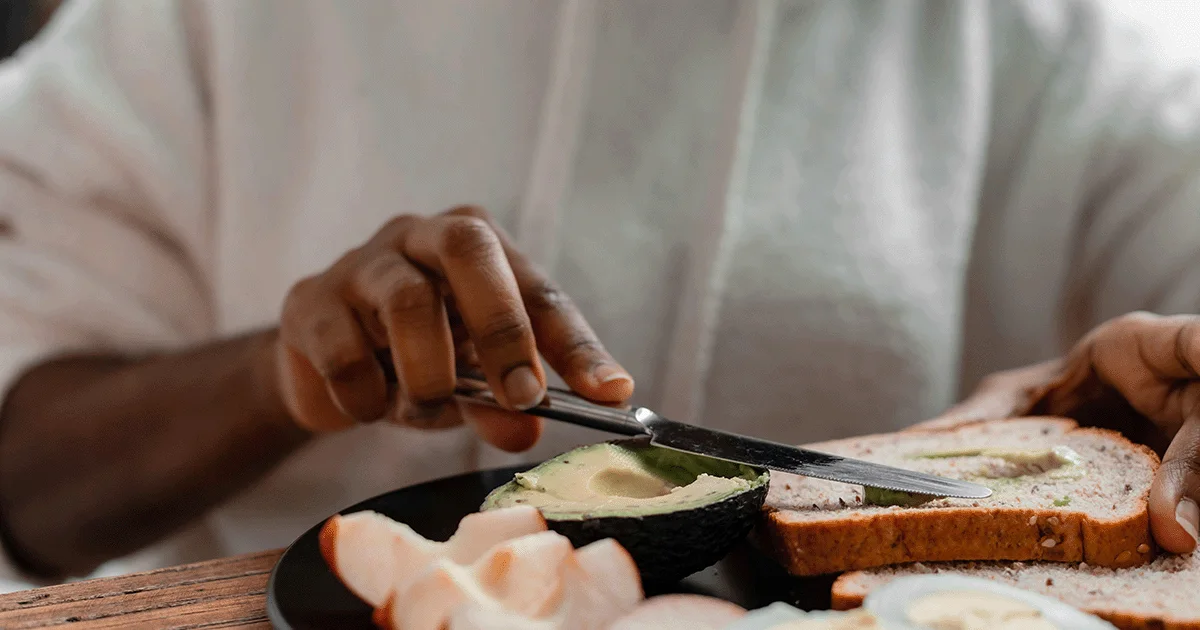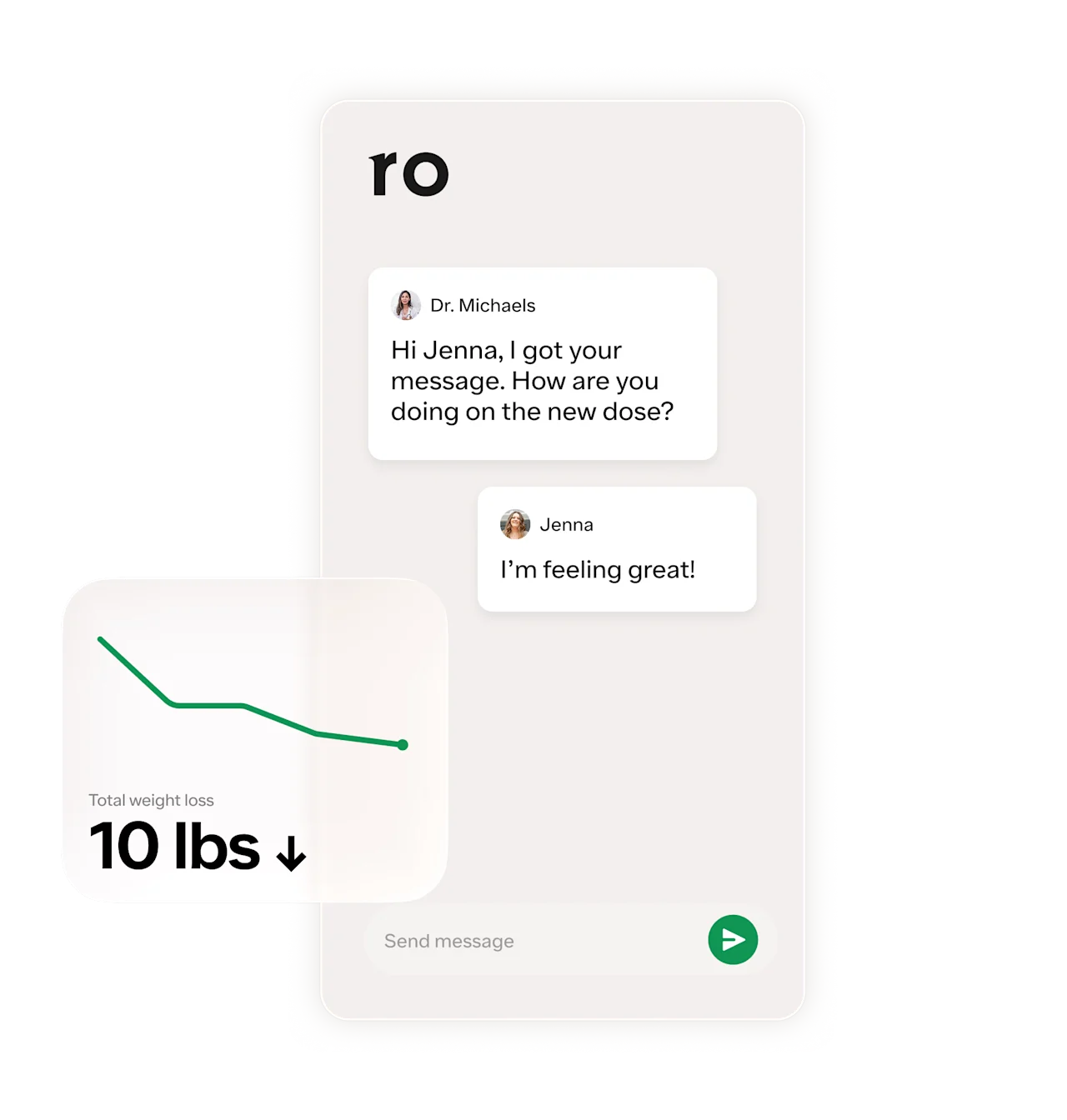Key takeaways
Insulin resistance occurs when your cells don’t respond as well to insulin, the hormone that regulates blood glucose levels by helping glucose enter your cells.
An insulin resistance diet focuses on foods high in fiber, antioxidants, and anti-inflammatory nutrients, which could improve how your cells respond to insulin over time.
Eating certain foods (e.g. fruits, vegetables, lean proteins, whole grains) and avoiding others as part of an insulin resistance diet can help reduce the risk of developing type 2 diabetes and improve metabolic health.
Here's what we'll cover
Here's what we'll cover
Here's what we'll cover
Key takeaways
Insulin resistance occurs when your cells don’t respond as well to insulin, the hormone that regulates blood glucose levels by helping glucose enter your cells.
An insulin resistance diet focuses on foods high in fiber, antioxidants, and anti-inflammatory nutrients, which could improve how your cells respond to insulin over time.
Eating certain foods (e.g. fruits, vegetables, lean proteins, whole grains) and avoiding others as part of an insulin resistance diet can help reduce the risk of developing type 2 diabetes and improve metabolic health.
Maybe you’re concerned about developing type 2 diabetes or managing the symptoms of a condition like PCOS. Or perhaps you’re just interested in promoting a healthy pancreas. Whatever the case may be, adopting an insulin resistance diet could be a key step toward better metabolic (and overall!) health.
So, what does this look like exactly? Keep reading to learn all about an insulin resistance diet.
Insulin resistance and diet
First, a quick explainer: Food is a source of energy and sometimes the energy is obtained from glucose, or sugar. When you eat food, your blood glucose naturally increases, prompting beta-cells in your pancreas to release insulin, a type of hormone. Insulin helps blood glucose enter your cells, allowing them to use glucose for energy. This keeps your blood glucose levels in check.
Insulin resistance happens when your cells have a hard time responding to insulin. As a result, glucose can’t easily enter your cells and builds up in the blood instead. Over time, this consistently high blood sugar can lead to type 2 diabetes.
What causes insulin resistance, exactly? There are many potential reasons—including genetics, certain health conditions, lack of physical activity, some medications, and aging—but diet is a major one. Specifically, a high intake of fast foods, fatty meats, refined grains, and sugar-sweetened beverages can make it difficult for insulin to function properly, increasing the risk of developing insulin resistance. With that in mind, dietary changes can promote healthy blood glucose levels, making it a major part of managing or even reversing insulin resistance.
Insulin resistance diet tips
Choose low-glycemic index foods. The glycemic index measures how quickly a food increases blood sugar. The scale ranges between 0-100; the lower the number assigned to a food, the slower it increases blood sugar, making it better for insulin resistance. For an insulin resistance diet, focus on low glycemic foods, which are ranked 55 or lower.
Get regular exercise. Staying active is one of the best things you can do for insulin resistance and diabetes risk. More specifically, aerobic exercise (i.e. cardio) can boost insulin sensitivity, potentially improving how your cells respond and take up insulin.
Avoid yo-yo dieting. Yo-yo dieting, or weight cycling, is when you repeatedly lose a lot of weight, only to regain it back. This can happen after starting and stopping restrictive diets, causing your weight to repeatedly fluctuate. These intense changes trigger an inflammatory response in fat tissue, making it difficult for cells to interact with insulin.
Foods to eat if you have insulin resistance
1. Whole grains
Contrary to popular belief, carbohydrates aren’t off limits when it comes to insulin control. It’s all about the type of carbs you eat. Whole grains, such as oatmeal, quinoa, barley, and whole-wheat bread and pasta, can be beneficial for insulin resistance when consumed in modest quantities, so they deserve a spot on your plate.
Compared to refined grains (e.g. white bread), whole grains contain more anti-inflammatory nutrients, including fiber, antioxidants, vitamins, and minerals. This is good news for reducing insulin resistance, as inflammation can be a contributing factor. What’s more, whole grains are richer in fiber than processed grains. Fiber can slow down glucose absorption in the blood, which can reduce the body’s need for insulin, ultimately improving insulin resistance.
2. Non-starchy vegetables
Non-starchy vegetables are vegetables that are—you guessed it—low in starch, a type of sugar. Examples of non-starchy vegetables include cabbage, tomatoes, asparagus, zucchini, and leafy greens.
When it comes to a diet for insulin resistance, non-starchy vegetables get two thumbs up. They have a low glycemic index, meaning they won’t rapidly boost blood sugar and increase the need for insulin. Non-starchy vegetables are also typically higher in fiber than starchy vegetables (which have more sugar), further pumping the brakes on blood sugar increases.
Plus, many vegetables in general are anti-inflammatory and stellar sources of antioxidants, which can help target inflammation, another factor involved in insulin resistance.
3. Most fruits
Although fruits are naturally sweet, many of them have a low glycemic index, making them appropriate for an insulin resistance diet. In fact, fruit has been shown to lower the risk of type 2 diabetes—that is, of course, when consumed in recommended amounts.
This can be due to several reasons. For starters, fruits are full of fiber, which can slow glucose absorption into the blood. Fiber can also improve how glucose is metabolized, or broken down, in the body. Additionally, many fruits are rich in antioxidants like flavonoids. These compounds can support beta-cells in the pancreas, which are in charge of releasing insulin. The result? Better insulin sensitivity in people with diabetes mellitus.
4. Beans and legumes
Beans and legumes, such as chickpeas, kidney beans, peas, and lentils, can also have a place in an insulin resistance diet. Not only are they a low glycemic index food, but beans and legumes offer a myriad of nutrients that can benefit insulin resistance.
The most noteworthy nutrient is fiber, which, again, can improve blood glucose control and insulin resistance. Beans and legumes are also lean proteins, meaning they‘re low in saturated fat. This is noteworthy because high intakes of saturated fat are linked with weight gain and obesity—two major risk factors for insulin resistance and diabetes.
5. Fatty fish
If you have insulin resistance, consider eating more fatty fish, such as salmon, mackerel, herring, sardines, and tuna. One study found that oily fish (and consumption of fish oil supplements) were linked to a lower risk of type 2 diabetes largely due to the beneficial effects on insulin and blood glucose control that are thanks to the healthy omega-3 fatty acids. Need a quick refresher? Omega-3 fats are polyunsaturated fatty acids (PUFAs), “good” fats that can lower inflammation, which is key for reducing the risk of insulin resistance.
But wait, there’s more: Omega-3 fatty acids are needed to keep cell walls strong, healthy, and flexible. When these features are in place, cells can communicate better with other cells. As a result, cells can use energy better, which supports overall metabolism. This may lower the risk of metabolic diseases, including insulin resistance and type 2 diabetes.
6. Nuts
Nuts, including hazelnuts, cashews, peanuts, walnuts, macadamias, and pecans, can be part of an insulin resistance diet. They have plenty of anti-inflammatory nutrients, including fiber, antioxidants, and PUFAs. This is key because inflammation can make it difficult for glucose to metabolize properly, increasing the risk for insulin resistance. Remember that nuts are a high-calorie food and watch the amount you are consuming to avoid compromising any weight loss goals you might have.
7. Green tea
Green tea may be able to help insulin resistance due in part to epigallocatechin-3-gallate, a type of catechin (i.e. antioxidant) found in the tea, but results are still inconclusive. While one small study found that green tea catechins (when combined with coffee chlorogenic acids) can improve insulin sensitivity, another 2023 study found that green tea was associated with poor insulin resistance. A different 2020 meta-analysis found that green tea has no effect on insulin. Point being: More research is needed to truly determine green tea’s impact on insulin and insulin resistance. The studies also varied in terms of the populations that were studied and even had slightly different methods, making it difficult to interpret the results. In the meantime, including moderate amounts of unsweetened tea in an insulin resistance diet is fairly low-risk and could even offer some benefit.
8. Chicken
Another lean protein to include in an insulin resistance diet? Chicken. In a large study of adults greater than 50 years in age, the combination of eating chicken and reducing carbohydrate intake improved insulin resistance. The researchers linked the effects to histidine-containing dipeptides, which are molecules that may reduce blood glucose and benefit insulin resistance.
Additionally, high-protein foods in general tend to be beneficial for insulin resistance, as noted in a small study involving women with obesity and insulin resistance. It’s due to the satiating effects of protein, which can promote weight loss and therefore, a better response to insulin. Chicken fits the bill, as it’s a lean high-protein food; a 4-oz serving of boneless skinless chicken offers 26 grams of protein (and less than 1 gram of fat).
Foods to avoid if you have insulin resistance
Refined carbohydrates. If you have insulin resistance, consider limiting or omitting refined carbs, such as white bread and pasta. These foods have a higher glycemic load than whole grains, meaning they can trigger quicker blood sugar spikes. And remember: Blood sugar spikes can be bad for insulin resistance because they overwhelm the cells, making it hard for them to respond to insulin.
Sugar-sweetened foods and drinks. Sugary beverages and bites, such as soda, candy, and baked goods, can cause blood glucose spikes and, in turn, increase insulin. If this repeatedly happens, insulin resistance can lead to type 2 diabetes. To reduce the risk, get into the habit of reaching for a naturally sweet treat, such as a balanced smoothie, dark chocolate, or berries, instead.
Red meat. A high intake of red meat can increase the risk of obesity, which can contribute to insulin resistance. This can be due to the high saturated and trans fat in red meat. Consider replacing these types of protein with other options, such as fatty fish, beans, legumes, and poultry.
Diets for insulin resistance
It’s worth noting that there’s not one specific insulin resistance diet, but there are other eating plans that have been shown to help insulin resistance. In general, these diets can benefit insulin resistance because they’re beneficial for maintaining a healthy weight overall and are high in inflammation-lowering, blood sugar-regulating nutrients.
Mediterranean diet
The Mediterranean diet is based on the typical eating patterns of countries bordering the Mediterranean Sea, including Greece, Italy, and Spain. It focuses on whole foods, healthy fats, and lean protein (e.g. fresh vegetables, legumes, nuts, olive oil, and fatty fish) and involves a moderate intake of dairy and wine—all while limiting red meat and sugar.
Overall, the Mediterranean diet emphasizes anti-inflammatory foods, making it potentially helpful for improving insulin resistance in those with overweight and obesity without diabetes. It’s also been associated with weight loss, which may reduce the risk of obesity, another contributing factor of insulin resistance.
DASH diet
Another diet for insulin resistance is the DASH (Dietary Approaches to Stop Hypertension) diet, which emphasizes foods high in protein, fiber, potassium, calcium, and magnesium and those low in saturated fat, cholesterol, and sodium. Think: fruits, vegetables, poultry, fish, nuts, whole grains, and low-fat or fat-free dairy products.
As the name suggests, the DASH diet can be particularly effective at reducing hypertension (aka high blood pressure), making it a heart-healthy eating plan. As a bonus, it can also improve insulin resistance and reduce diabetes risk. This is because the DASH diet prioritizes foods that are rich in fiber and antioxidants. The eating plan has also been shown to support a healthy weight, which is key for controlling insulin resistance.
Bottom line on insulin resistance diet
If you have insulin resistance, it doesn’t necessarily mean you’ll develop type 2 diabetes. Adopting certain lifestyle habits, particularly dietary changes, can greatly reduce the risk. To eat for insulin resistance, focus on whole grains, non-starchy vegetables, moderate amounts of most fruit, fatty fish, nuts, and green tea. The fiber, antioxidants, and anti-inflammatory nutrients in these foods can help control blood sugar levels, potentially improving insulin resistance. While you’re at it, limit or avoid refined grains, sugary drinks and snacks, and red meat; these foods are high in either sugar or saturated fat, which can make it difficult for insulin to work properly.
Not sure where to start? Chat with a healthcare provider, who can provide personalized tips on dietary changes based on your specific medical history and needs.
DISCLAIMER
If you have any medical questions or concerns, please talk to your healthcare provider. The articles on Health Guide are underpinned by peer-reviewed research and information drawn from medical societies and governmental agencies. However, they are not a substitute for professional medical advice, diagnosis, or treatment.
References
Bielefeld, D., Grafenauer, S., & Rangan, A. (2020). The effects of legume consumption on markers of glycaemic control in individuals with and without diabetes mellitus: A systematic literature review of randomised controlled trials. Nutrients, 12(7), 2123. doi: 10.3390/nu12072123. Retrieved from https://www.mdpi.com/2072-6643/12/7/2123
Bird, S. R. & Hawley, J. A. (2017). Update on the effects of physical activity on insulin sensitivity in humans. BMJ Open Sport & Exercise Medicine, 2(1), e000143. doi: 10.1136/bmjsem-2016-000143. Retrieved from https://www.ncbi.nlm.nih.gov/pmc/articles/PMC5569266/
Bondonno, N. P., Davey, R. J., Murray, K., et al. (2021). Associations between fruit intake and risk of diabetes in the AusDiab cohort. The Journal of Clinical Endocrinology & Metabolism, 106(10), e4097-e4108. doi: 10.1210/clinem/dgab335. Retrieved from https://academic.oup.com/jcem/article/106/10/e4097/6290732
Calcaterra, V., Cena, H., Magenes, V. C., et al. (2023). Sugar-sweetened beverages and metabolic risk in children and adolescents with obesity: A narrative review. Nutrients, 15(3), 702. doi: 10.3390/nu15030702. Retrieved from https://www.ncbi.nlm.nih.gov/pmc/articles/PMC9918944/
Campbell, A. P. (2017). DASH eating plan: An eating pattern for diabetes management. Diabetes Spectrum, 30(2), 76-81. doi: 10.2337/ds16-0084. Retrieved from https://diabetesjournals.org/spectrum/article/30/2/76/32278/DASH-Eating-Plan-An-Eating-Pattern-for-Diabetes
Chen, G., Arthur, R., Qin, K., et al. (2021). Association of oily and nonoily fish consumption and fish oil supplements with incident Type 2 diabetes: A large population-based prospective study. Diabetes Care, 44(3). doi: 10.2337/dc20-2328. Retrieved from https://diabetesjournals.org/care/article/44/3/672/138757/Association-of-Oily-and-Nonoily-Fish-Consumption
Drewnowski, A., Maillot, M., & Vieux, F. (2022). Multiple metrics of carbohydrate quality place starchy vegetables alongside non-starchy vegetables, legumes, and whole fruit. Frontiers in Nutrition, 9, 867378. doi: 10.3389/fnut.2022.867378. Retrieved from https://www.frontiersin.org/journals/nutrition/articles/10.3389/fnut.2022.867378/full
Fan, M., Li, Y., Wang, C., et al. (2019). Dietary protein consumption and the risk of type 2 diabetes: A dose-response meta-analysis of prospective studies. Nutrients, 11(11), 2783. doi: 10.3390/nu11112783. Retrieved from https://www.ncbi.nlm.nih.gov/pmc/articles/PMC6893550/
Goff, H. D., Repin, N., Fabek, H., et al. (2018). Dietary fibre for glycaemia control: Towards a mechanistic understanding. Bioactive Carbohydrates and Dietary Fibre, 14, 39-53. doi: 10.1016/j.bcdf.2017.07.005. Retrieved from https://www.sciencedirect.com/science/article/abs/pii/S2212619817300128
Hernández-Alonso, P., Camacho-Barcia, L., Bulló, M., et al. (2017). Nuts and dried fruits: An Update of their beneficial effects on Type 2 diabetes. Nutrients, 9(7), 673. doi: 10.3390/nu9070673. Retrieved from https://www.ncbi.nlm.nih.gov/pmc/articles/PMC5537788/
Ma, K. & Dhawan, S. (2022). Yo-yo dieting: Mixed messages for β-Cell plasticity. Diabetes, 71(11), 2253-2255. doi: 10.2337/dbi22-0024. Retrieved from https://diabetesjournals.org/diabetes/article/71/11/2253/147763/Yo-Yo-Dieting-Mixed-Messages-for-Cell-Plasticity
McMacken, M. & Shah, S. (2017). A plant-based diet for the prevention and treatment of type 2 diabetes. Journal of Geriatric Cardiology : JGC, 14(5), 342–354. doi: 10.11909/j.issn.1671-5411.2017.05.009. Retrieved from https://www.ncbi.nlm.nih.gov/pmc/articles/PMC5466941/
Milesi, G., Rangan, A., & Grafenauer, S. (2022). Whole grain consumption and inflammatory markers: A systematic literature review of randomized control trials. Nutrients, 14(2), 374. doi: 10.3390/nu14020374. Retrieved from https://www.ncbi.nlm.nih.gov/pmc/articles/PMC8778110/
Papakonstantinou, E., Oikonomou, C., Nychas, G., et al. (2022). Effects of diet, lifestyle, chrononutrition and alternative dietary interventions on postprandial glycemia and insulin resistance. Nutrients, 14(4), 823. doi: 10.3390/nu14040823. Retrieved from https://www.ncbi.nlm.nih.gov/pmc/articles/PMC8878449/
Rehman, K. & Akash, M. S. H. (2016). Mechanisms of inflammatory responses and development of insulin resistance: how are they interlinked? Journal of Biomedical Science, 23(87). doi: 10.1186/s12929-016-0303-y. Retrieved from https://jbiomedsci.biomedcentral.com/articles/10.1186/s12929-016-0303-y
Sinha, S., Haque, M., Lugova, H., et al. (2023). The effect of omega-3 fatty acids on insulin resistance. Life, 13(6), 1322. doi: 10.3390/life13061322. Retrieved from https://www.mdpi.com/2075-1729/13/6/1322
Sood, S., Feehan, J., Itsiopoulos C., et al. (2022). Higher adherence to a Mediterranean diet is associated with improved sensitivity and selected markers of inflammation in individuals who are overweight and obese without diabetes. Nutrients, 14(20), 4437. doi: 10.3390/nu14204437. Retrieved from https://www.mdpi.com/2072-6643/14/20/4437
Tettamanzi, F., Bagnardi, V., Louca, P., et al. (2021). A High Protein Diet Is More Effective in Improving Insulin Resistance and Glycemic Variability Compared to a Mediterranean Diet—A Cross-Over Controlled Inpatient Dietary Study. Nutrients, 13, 4380. doi: 10.3390/nu13124380. Retrieved from https://pdfs.semanticscholar.org/bbf2/60fafaf9c6e39133402a67c5e2fe5fd723f8.pdf
Thota, S. & Akbar, A. (2023). Insulin. StatPearls. Retrieved from https://www.ncbi.nlm.nih.gov/books/NBK560688/
Tosti, V., Bertozzi, B., & Fontana, L. (2018). Health benefits of the Mediterranean diet: Metabolic and molecular mechanisms. The Journals of Gerontology Series A: Biological Sciences and Medical Sciences, 73(3), 318-326. doi: 10.1093/gerona/glx227. Retrieved from https://www.ncbi.nlm.nih.gov/pmc/articles/PMC7190876/
U.S. Department of Agriculture, Agricultural Research Service (USDA). (2019). FoodData Central: Boneless skinless chicken breasts. Retrieved from https://fdc.nal.usda.gov/fdc-app.html#/food-details/577591/nutrients
Xu, R., Bai, Y., Yang, K., & Chen, G. (2020). Effects of green tea consumption on glycemic control: a systematic review and meta-analysis of randomized controlled trials. Nutrition & Metabolism, 17, 56. doi: 10.1186/s12986-020-00469-5. Retrieved from https://nutritionandmetabolism.biomedcentral.com/articles/10.1186/s12986-020-00469-5
Yanagimoto, A., Matsui, Y., Yamaguchi, T., et al. (2022). Effects of Ingesting Both Catechins and Chlorogenic Acids on Glucose, Incretin, and Insulin Sensitivity in Healthy Men: A Randomized, Double-Blinded, Placebo-Controlled Crossover Trial. Nutrients, 14(23), 5063. doi: 10.3390/nu14235063. Retrieved from https://www.ncbi.nlm.nih.gov/pmc/articles/PMC9737369/
Yeum, K. J., Kim, Y. S., & Joo, N. S. (2020). Chicken consumption and insulin resistance in non-diabetic older adults. Journal of Nutrition and Health, 53(4), 356-368. doi: 10.4163/jnh.2020.53.4.356. Retrieved from https://e-jnh.org/DOIx.php?id=10.4163/jnh.2020.53.4.356
Yi, X., Dong, M., Guo, N., et al. (2023). Flavonoids improve type 2 diabetes mellitus and its complications: a review. Frontiers in Nutrition, 10, 1192131. doi: 10.3389/fnut.2023.1192131. Retrieved from https://www.frontiersin.org/journals/nutrition/articles/10.3389/fnut.2023.1192131/full
Yu, D., Shu, X. O., Li, H., et al. (2013). Dietary carbohydrates, refined grains, glycemic load, and risk of coronary heart disease in Chinese adults. American Journal of Epidemiology, 178(10), 1542–1549. doi: 10.1093/aje/kwt178. Retrieved from https://www.ncbi.nlm.nih.gov/pmc/articles/PMC3888273/
Zhang, Y., Bian, Z., Lu, H., et al. (2023). Association between tea consumption and glucose metabolism and insulin secretion in the Shanghai High-risk Diabetic Screen (SHiDS) study. BMJ Open Diabetes Research & Care, 11(2), e003266. doi: 10.1136/bmjdrc-2022-003266. Retrieved from https://www.ncbi.nlm.nih.gov/pmc/articles/PMC10030497/













